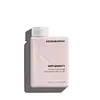What's inside
What's inside
 Key Ingredients
Key Ingredients

No key ingredients
 Benefits
Benefits

 Concerns
Concerns

 Ingredients Side-by-side
Ingredients Side-by-side

Water
Skin ConditioningVp/Va Copolymer
Lavandula Angustifolia Flower
Skin ConditioningVp/Dmapa Acrylates Copolymer
Squalane
EmollientSodium Polyacryloyldimethyl Taurate
Emulsion StabilisingHydrogenated Polydecene
EmollientTrideceth-10
CleansingPolysorbate 60
EmulsifyingPolysorbate 20
EmulsifyingPhenoxyethanol
PreservativeBenzoic Acid
MaskingDehydroacetic Acid
PreservativeSodium Laneth-40 Maleate/Styrene Sulfonate Copolymer
Parfum
MaskingLimonene
PerfumingBenzyl Benzoate
AntimicrobialLinalool
PerfumingWater, Vp/Va Copolymer, Lavandula Angustifolia Flower, Vp/Dmapa Acrylates Copolymer, Squalane, Sodium Polyacryloyldimethyl Taurate, Hydrogenated Polydecene, Trideceth-10, Polysorbate 60, Polysorbate 20, Phenoxyethanol, Benzoic Acid, Dehydroacetic Acid, Sodium Laneth-40 Maleate/Styrene Sulfonate Copolymer, Parfum, Limonene, Benzyl Benzoate, Linalool
Water
Skin ConditioningDipropylene Glycol
HumectantPolysilicone-29
Isopentyldiol
HumectantTilia Tomentosa Bud Extract
Skin ConditioningTelopea Speciosissima Flower/Leaf Extract
AntioxidantGlycolic Acid
BufferingGlycerin
HumectantSilicone Quaternium-18
EmollientTrideceth-6
EmulsifyingTrideceth-12
EmulsifyingPolysorbate 20
EmulsifyingTetrasodium Glutamate Diacetate
BHT
AntioxidantPhenoxyethanol
PreservativePotassium Sorbate
PreservativeSodium Benzoate
MaskingCitric Acid
BufferingSodium Hydroxide
BufferingParfum
MaskingLimonene
PerfumingHydroxycitronellal
PerfumingLinalool
PerfumingAlpha-Isomethyl Ionone
PerfumingWater, Dipropylene Glycol, Polysilicone-29, Isopentyldiol, Tilia Tomentosa Bud Extract, Telopea Speciosissima Flower/Leaf Extract, Glycolic Acid, Glycerin, Silicone Quaternium-18, Trideceth-6, Trideceth-12, Polysorbate 20, Tetrasodium Glutamate Diacetate, BHT, Phenoxyethanol, Potassium Sorbate, Sodium Benzoate, Citric Acid, Sodium Hydroxide, Parfum, Limonene, Hydroxycitronellal, Linalool, Alpha-Isomethyl Ionone
Alternatives
Ingredients Explained
These ingredients are found in both products.
Ingredients higher up in an ingredient list are typically present in a larger amount.
Limonene is a fragrance that adds scent and taste to a formulation.
It's found in the peel oil of citrus fruits and other plants such as lavender and eucalyptus. The scent of limonene is generally described as "sweet citrus".
Limonene acts as an antioxidant, meaning it helps neutralize free radicals.
When exposed to air, oxidized limonene may sensitize the skin. Because of this, limonene is often avoided by people with sensitive skin.
The term 'fragrance' is not regulated in many countries. In many cases, it is up to the brand to define this term. For instance, many brands choose to label themselves as "fragrance-free" because they are not using synthetic fragrances. However, their products may still contain ingredients such as essential oils that are considered a fragrance.
Learn more about LimoneneLinalool is a fragrance and helps add scent to products. It's derived from common plants such as cinnamon, mint, citrus, and lavender.
Like Limonene, this ingredient oxidizes when exposed to air. Oxidized linalool can cause allergies and skin sensitivity.
This ingredient has a scent that is floral, spicy tropical, and citrus-like.
Learn more about LinaloolParfum is a catch-all term for an ingredient or more that is used to give a scent to products.
Also called "fragrance", this ingredient can be a blend of hundreds of chemicals or plant oils. This means every product with "fragrance" or "parfum" in the ingredients list is a different mixture.
For instance, Habanolide is a proprietary trade name for a specific aroma chemical. When used as a fragrance ingredient in cosmetics, most aroma chemicals fall under the broad labeling category of “FRAGRANCE” or “PARFUM” according to EU and US regulations.
The term 'parfum' or 'fragrance' is not regulated in many countries. In many cases, it is up to the brand to define this term.
For instance, many brands choose to label themselves as "fragrance-free" because they are not using synthetic fragrances. However, their products may still contain ingredients such as essential oils that are considered a fragrance by INCI standards.
One example is Calendula flower extract. Calendula is an essential oil that still imparts a scent or 'fragrance'.
Depending on the blend, the ingredients in the mixture can cause allergies and sensitivities on the skin. Some ingredients that are known EU allergens include linalool and citronellol.
Parfum can also be used to mask or cover an unpleasant scent.
The bottom line is: not all fragrances/parfum/ingredients are created equally. If you are worried about fragrances, we recommend taking a closer look at an ingredient. And of course, we always recommend speaking with a professional.
Learn more about ParfumPhenoxyethanol is a preservative that has germicide, antimicrobial, and aromatic properties. Studies show that phenoxyethanol can prevent microbial growth. By itself, it has a scent that is similar to that of a rose.
It's often used in formulations along with Caprylyl Glycol to preserve the shelf life of products.
Polysorbate 20 is made by combining ethoxylation of sorbitan, ethylene oxide, and lauric acid. It is a mild cleansing agent, surfactant, and emulsifier.
As a surfactant, it helps collect dirt and oils for washing. Emulsifiers prevent oils and water from separating.
Polysorbate 20 also adds scent to a product. Since it is made using sorbitol, it has a sweet scent. Sorbitol can also be found in fruits such as apples and peaches.
The lauric acid used to create Polysorbate 20 is often derived from coconuts.
Polysorbate 20 may not be fungal acne safe.
Learn more about Polysorbate 20Water. It's the most common cosmetic ingredient of all. You'll usually see it at the top of ingredient lists, meaning that it makes up the largest part of the product.
So why is it so popular? Water most often acts as a solvent - this means that it helps dissolve other ingredients into the formulation.
You'll also recognize water as that liquid we all need to stay alive. If you see this, drink a glass of water. Stay hydrated!
Learn more about Water